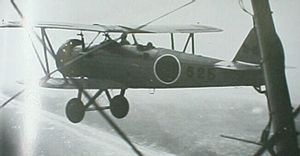Design and development
The aircraft was based on the Yokosuka Navy Type 91 Intermediate Trainer, but stability problems led to a redesign by Kawanishi in 1933. It entered service in 1934 as Navy Type 93 Intermediate Trainer K5Y1 with fixed tail-skid landing gear and remained in use throughout the war. Floatplane types K5Y2 and K5Y3 were also produced. After the initial sixty examples by Kawanishi, production was continued by Watanabe (556 aircraft built), Mitsubishi (60), Hitachi (1,393), First Naval Air Technical Arsenal (75), Nakajima (24), Nippon (2,733), and Fuji (896) - for a total of 5,770. These aircraft were the mainstay of Imperial Japanese Navy Air Service's flight training, and, as intermediate trainers, they were capable of performing demanding aerobatic maneuvers. Two further land-based versions, the K5Y4 with a 358 kW (480 hp) Amakaze 21A engine and the K5Y5 with a 384 kW (515 hp) Amakaze 15, were projected but never built. [2]

The Aichi B7A Ryusei was a large and powerful carrier-borne torpedo-dive bomber produced by Aichi Kokuki for the Imperial Japanese Navy Air Service during the Second World War. Built in only small numbers and deprived of the aircraft carriers it was intended to operate from, the type had little chance to distinguish itself in combat before the war ended in August 1945.
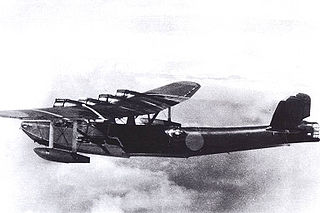
The Kawanishi H6K was an Imperial Japanese Navy flying boat produced by the Kawanishi Aircraft Company and used during World War II for maritime patrol duties. The Allied reporting name for the type was Mavis; the Navy designation was "Type 97 Large Flying Boat" (九七式大型飛行艇). Developed in the 1930s, it was used for reconnaissance, transport, bombing, naval warfare, and executive transport by the Imperial Japanese Navy. The national airline also used it as commercial airliner. The British mistakenly identified this aircraft as the Kawanishi Navy 97 Mavis.

The Kawanishi H8K is a flying boat used by the Imperial Japanese Navy Air Service during World War II for maritime patrol duties. The Allied reporting name for the type was "Emily".

The Mitsubishi A5M, formal Japanese Navy designation Mitsubishi Navy Type 96 Carrier-based Fighter (九六式艦上戦闘機), experimental Navy designation Mitsubishi Navy Experimental 9-Shi Carrier Fighter, company designation Mitsubishi Ka-14, was a WWII-era Japanese carrier-based fighter aircraft. The Type number is from the last two digits of the Japanese imperial year 2596 (1936) when it entered service with the Imperial Navy.

The Yokosuka D4Y Suisei is a two-seat carrier-based dive bomber developed by the Yokosuka Naval Air Technical Arsenal and operated by the Imperial Japanese Navy from 1942 to 1945 during World War II. Development of the aircraft began in 1938. The first D4Y1 was complete in November 1940 and made its maiden flight at Yokosuka the following month.
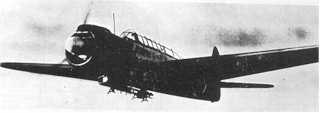
The Nakajima B6N Tenzan was the Imperial Japanese Navy's standard carrier-borne torpedo bomber during the final years of World War II and the successor to the B5N "Kate". Due to its protracted development, a shortage of experienced pilots and the United States Navy's achievement of air superiority by the time of its introduction, the B6N was never able to fully demonstrate its combat potential.

The Mitsubishi F1M is a Japanese reconnaissance floatplane of World War II. It was the last biplane type of the Imperial Japanese Navy, with 944 built between 1936 and 1944. The Navy designation was "Type Zero Observation Seaplane" (零式水上観測機).

The Yokosuka P1Y Ginga is a twin-engine, land-based bomber developed for the Japanese Imperial Navy in World War II. It was the successor to the Mitsubishi G4M and given the Allied reporting name Frances.

The Kyūshū Q1WTōkai was a land-based, anti-submarine patrol bomber aircraft developed for the Imperial Japanese Navy in World War II. The Allied reporting name was Lorna. Although similar in appearance to the German Junkers Ju 88 medium bomber, the Q1W was a much smaller aircraft with significantly different design details.
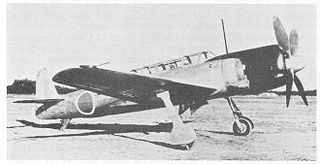
The Nakajima C6NSaiun is a carrier-based reconnaissance aircraft used by the Imperial Japanese Navy Air Service in World War II. Advanced for its time, it was the fastest carrier-based aircraft put into service by Japan during the war. The Allied reporting name was Myrt.

The Yokosuka E14Y was an Imperial Japanese Navy reconnaissance seaplane transported aboard and launched from Japanese submarine aircraft carriers, such as the I-25 during World War II. The Japanese Navy designation was "Type 0 Small Reconnaissance Seaplane" (零式小型水上偵察機).

The Mitsubishi G3M was a Japanese bomber and transport aircraft used by the Imperial Japanese Navy Air Service (IJNAS) during World War II.
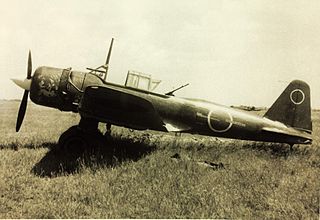
The Mitsubishi Ki-51 was a light bomber/dive bomber in service with the Imperial Japanese Army during World War II. It first flew in mid-1939. Initially deployed against Chinese forces, it proved to be too slow to hold up against the fighter aircraft of the other Allied powers. However, it performed a useful ground-attack role in the China-Burma-India theater, notably from airfields too rough for many other aircraft. As the War drew to a close, the Japanese began using them in kamikaze attacks. Total production was around 2,385.

The Yokosuka B4Y was a carrier-borne torpedo bomber used by the Imperial Japanese Navy Air Service from 1936 to 1943. The B4Y replaced the Mitsubishi B2M2 and the Yokosuka B3Y, and was the last biplane bomber used operationally by the Imperial Japanese Navy. The Allied reporting name was "Jean". This aircraft was mistakenly identified by the British as the Nakajima Navy G-96.

The Aichi E16A Zuiun was a two-seat reconnaissance seaplane operated by the Imperial Japanese Navy during World War II.

The Mitsubishi K3M was a trainer built by Mitsubishi which was used by the Imperial Japanese Navy in an extremely wide variety of roles, including light transport, liaison aircraft, utility aircraft, and occasionally light bomber. Its Allied reporting name was Pine.
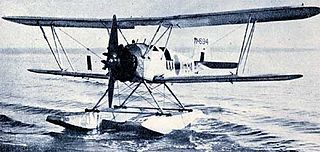
The Yokosuka K4Y was a Japanese floatplane trainer of the 1930s. A single engined two-seat biplane, 211 K4Ys were built between 1933 and 1940, serving as the Imperial Japanese Navy's basic floatplane trainer throughout the Second World War.

The Yokosuka K1Y, also known as the Navy Type 13 Trainer, was a Japanese single-engined biplane trainer of the 1920s. Designed by the Japanese Navy Arsenal at Yokosuka, over 100 were built by several manufacturers and was used by the Imperial Japanese Navy well into the 1930s.
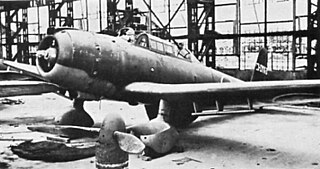
The Yokosuka D3Y Myōjō was a Japanese, two-seat dive bomber/trainer designed and built by the Yokosuka Naval Air Technical Arsenal. Derived from the Aichi D3A, it was made nearly entirely of wood in an attempt to conserve valuable resources. Upon Japan's surrender, the project came to a halt with only a few aircraft delivered as the Navy Type 99 Bomber Trainer Myōjō Model 22.
The Kawanishi K8K was a Japanese floatplane trainer designed and built by the Kawanishi Aircraft Company for the Imperial Japanese Navy. It was selected for production, but only a small number were built before a change in the Japanese Navy's training needs led to production being stopped.
